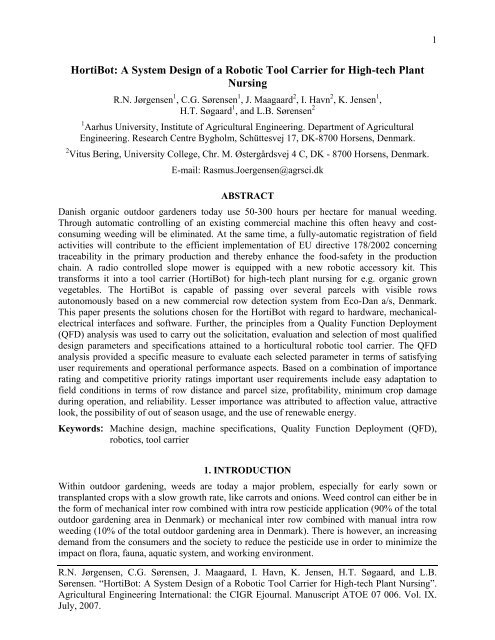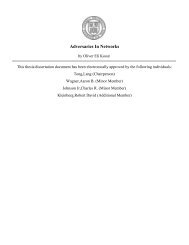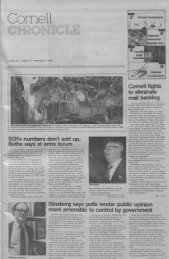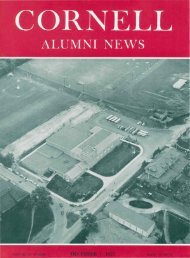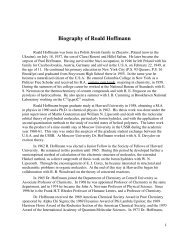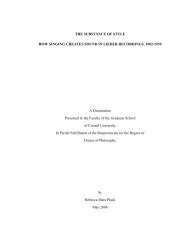A System Design of a Robotic Tool Carrier for High-tech Plant Nursing
A System Design of a Robotic Tool Carrier for High-tech Plant Nursing
A System Design of a Robotic Tool Carrier for High-tech Plant Nursing
Create successful ePaper yourself
Turn your PDF publications into a flip-book with our unique Google optimized e-Paper software.
HortiBot: A <strong>System</strong> <strong>Design</strong> <strong>of</strong> a <strong>Robotic</strong> <strong>Tool</strong> <strong>Carrier</strong> <strong>for</strong> <strong>High</strong>-<strong>tech</strong> <strong>Plant</strong><br />
<strong>Nursing</strong><br />
R.N. Jørgensen 1 , C.G. Sørensen 1 , J. Maagaard 2 , I. Havn 2 , K. Jensen 1 ,<br />
H.T. Søgaard 1 , and L.B. Sørensen 2<br />
1<br />
Aarhus University, Institute <strong>of</strong> Agricultural Engineering. Department <strong>of</strong> Agricultural<br />
Engineering. Research Centre Bygholm, Schüttesvej 17, DK-8700 Horsens, Denmark.<br />
2<br />
Vitus Bering, University College, Chr. M. Østergårdsvej 4 C, DK - 8700 Horsens, Denmark.<br />
E-mail: Rasmus.Joergensen@agrsci.dk<br />
ABSTRACT<br />
Danish organic outdoor gardeners today use 50-300 hours per hectare <strong>for</strong> manual weeding.<br />
Through automatic controlling <strong>of</strong> an existing commercial machine this <strong>of</strong>ten heavy and costconsuming<br />
weeding will be eliminated. At the same time, a fully-automatic registration <strong>of</strong> field<br />
activities will contribute to the efficient implementation <strong>of</strong> EU directive 178/2002 concerning<br />
traceability in the primary production and thereby enhance the food-safety in the production<br />
chain. A radio controlled slope mower is equipped with a new robotic accessory kit. This<br />
trans<strong>for</strong>ms it into a tool carrier (HortiBot) <strong>for</strong> high-<strong>tech</strong> plant nursing <strong>for</strong> e.g. organic grown<br />
vegetables. The HortiBot is capable <strong>of</strong> passing over several parcels with visible rows<br />
autonomously based on a new commercial row detection system from Eco-Dan a/s, Denmark.<br />
This paper presents the solutions chosen <strong>for</strong> the HortiBot with regard to hardware, mechanicalelectrical<br />
interfaces and s<strong>of</strong>tware. Further, the principles from a Quality Function Deployment<br />
(QFD) analysis was used to carry out the solicitation, evaluation and selection <strong>of</strong> most qualified<br />
design parameters and specifications attained to a horticultural robotic tool carrier. The QFD<br />
analysis provided a specific measure to evaluate each selected parameter in terms <strong>of</strong> satisfying<br />
user requirements and operational per<strong>for</strong>mance aspects. Based on a combination <strong>of</strong> importance<br />
rating and competitive priority ratings important user requirements include easy adaptation to<br />
field conditions in terms <strong>of</strong> row distance and parcel size, pr<strong>of</strong>itability, minimum crop damage<br />
during operation, and reliability. Lesser importance was attributed to affection value, attractive<br />
look, the possibility <strong>of</strong> out <strong>of</strong> season usage, and the use <strong>of</strong> renewable energy.<br />
Keywords: Machine design, machine specifications, Quality Function Deployment (QFD),<br />
robotics, tool carrier<br />
1. INTRODUCTION<br />
Within outdoor gardening, weeds are today a major problem, especially <strong>for</strong> early sown or<br />
transplanted crops with a slow growth rate, like carrots and onions. Weed control can either be in<br />
the <strong>for</strong>m <strong>of</strong> mechanical inter row combined with intra row pesticide application (90% <strong>of</strong> the total<br />
outdoor gardening area in Denmark) or mechanical inter row combined with manual intra row<br />
weeding (10% <strong>of</strong> the total outdoor gardening area in Denmark). There is however, an increasing<br />
demand from the consumers and the society to reduce the pesticide use in order to minimize the<br />
impact on flora, fauna, aquatic system, and working environment.<br />
R.N. Jørgensen, C.G. Sørensen, J. Maagaard, I. Havn, K. Jensen, H.T. Søgaard, and L.B.<br />
Sørensen. “HortiBot: A <strong>System</strong> <strong>Design</strong> <strong>of</strong> a <strong>Robotic</strong> <strong>Tool</strong> <strong>Carrier</strong> <strong>for</strong> <strong>High</strong>-<strong>tech</strong> <strong>Plant</strong> <strong>Nursing</strong>”.<br />
Agricultural Engineering International: the CIGR Ejournal. Manuscript ATOE 07 006. Vol. IX.<br />
July, 2007.<br />
1
Depending on the weed intensity, Danish outdoor gardeners use 50-300 h/ha <strong>for</strong> manual weeding<br />
in onions and carrots (Ørum and Christensen, 2001; Melander and Rasmussen, 2001). This is<br />
cost-intensive not only in direct labor costs but also in <strong>for</strong>m <strong>of</strong> labor allocated to this one<br />
operation relative to other urgent tasks within the growing season. Further, there are <strong>of</strong>ten<br />
difficulties associated with procuring the necessary labor.<br />
1.1 Robots within <strong>Plant</strong> Production and Outdoor Gardening <strong>for</strong> Weed Control Today<br />
With regards to relevant weeding robots, worldwide, there exists only a few today. In Denmark,<br />
there is a prototype called GreenTrac, which is designed as an environmentally sound tool carrier<br />
<strong>for</strong> organic outdoor gardeners. Currently, the GreenTrac is not matured <strong>for</strong> production and is<br />
unnecessary big <strong>for</strong> most tasks (Sørensen and Frederiksen, 2002). In Sweden, there is a robot <strong>for</strong><br />
intra row weeding in sugar beets (Åstrand and Baerveldt, 2002). Israel has a multi-functional<br />
prototype robot <strong>for</strong> transplanting and spraying (Edan and Bechar, 1998). In England, an outdoor<br />
gardening robot has been developed which is capable <strong>of</strong> passing over parcels <strong>of</strong> row crops (e.g.<br />
Hague et al., 1997). However, it cannot per<strong>for</strong>m proper field work.<br />
1.2 Today’s Technological Barriers<br />
The majority <strong>of</strong> agricultural prototype robots base its navigation on high precision satellite<br />
position systems, and on field and crop maps. Hence, it is relatively in<strong>for</strong>mation demanding and<br />
complex to work with. From the operator viewpoint, commercialization <strong>of</strong> a field robot requires<br />
that it is significantly simpler to operate (Callaghan et al., 1997; Jørgensen, 2005).<br />
A <strong>tech</strong>nological development <strong>of</strong> weeding robots depends, apart from the market situation, to a<br />
great extent on <strong>tech</strong>nological barriers and comparability with the existing <strong>tech</strong>nological stage.<br />
Kassler (2001) lists barriers that have retarded the exploitation <strong>of</strong> computer-controlled machines<br />
in agriculture, e.g.: Insufficiently robust mechanical <strong>tech</strong>nology; Costly mechanical <strong>tech</strong>nology;<br />
Limited capability; Basic knowledge to create <strong>tech</strong>nology as dexterous or as skilful as that <strong>of</strong> a<br />
trained worker is currently unavailable.<br />
1.3 The Voice <strong>of</strong> the Customer<br />
Within the concept <strong>of</strong> Total Quality Management (TQM), a number <strong>of</strong> tools have been adapted<br />
to assist the process <strong>of</strong> customer driven planning and engineering <strong>for</strong> product development<br />
(Cohen, 1995). One such tool is the Quality Function Deployment (QFD), which has as its<br />
primary goal the translation <strong>of</strong> customer requirements into <strong>tech</strong>nical requirements <strong>of</strong> each stage<br />
<strong>of</strong> the product design and production (Chan and Wu, 2001; Crowe and Cheng, 1996). The<br />
process involves identifying customers’ requirements <strong>for</strong> a product (WHATs), customers’ view<br />
on the relative importance <strong>of</strong> these requirements and the relative per<strong>for</strong>mance <strong>of</strong> the intended<br />
product and the main competitors on these requirements. Also, the complete QFD process<br />
includes translating the customer requirements into measurable engineering requirements<br />
(HOWs) through careful evaluations per<strong>for</strong>med by <strong>tech</strong>nicians recognizing the relationships<br />
between customer requirements and engineering characteristics.<br />
R.N. Jørgensen, C.G. Sørensen, J. Maagaard, I. Havn, K. Jensen, H.T. Søgaard, and L.B.<br />
Sørensen. “HortiBot: A <strong>System</strong> <strong>Design</strong> <strong>of</strong> a <strong>Robotic</strong> <strong>Tool</strong> <strong>Carrier</strong> <strong>for</strong> <strong>High</strong>-<strong>tech</strong> <strong>Plant</strong> <strong>Nursing</strong>”.<br />
Agricultural Engineering International: the CIGR Ejournal. Manuscript ATOE 07 006. Vol. IX.<br />
July, 2007.<br />
2
1.4 Aim and Deliverables<br />
The consumer driven demands to reduce the pesticide usage increases the demand <strong>for</strong><br />
mechanical weed control as a way to avoid costly hand weeding. Within a few years, new<br />
environmentally sound <strong>tech</strong>nologies are expected to replace hand weeding. However, this creates<br />
a demand <strong>for</strong> a mechanical unit which will be able to carry future high precision weeding tools<br />
with a low constant speed and high precision.<br />
The aim <strong>of</strong> this paper is to describe a developed robust horticultural robot called HortiBot, which<br />
will have the following main characteristics:<br />
• Capable <strong>of</strong> passing over several parcels with visible rows autonomously based on a<br />
commercial row detection system with no or minimal use <strong>of</strong> Global Positioning <strong>System</strong>s<br />
(GPS).<br />
• Unskilled workers will be able to operate the basic functions <strong>of</strong> the HortiBot followed by<br />
attending one hour <strong>of</strong> training.<br />
• All operational data is automatically sent to an internet based database.<br />
• The operation <strong>of</strong> the HortiBot is documented in terms <strong>of</strong> feasibility, operational capacity,<br />
and economy.<br />
Further, the objective is to identify qualified user requirements <strong>for</strong> the design <strong>of</strong> a robotic tool<br />
carrier to be used carrying various implements <strong>for</strong> plant nursing.<br />
1.5 Safety Emphasis<br />
Through automatic regulation <strong>of</strong> an existing commercial machine, heavy and cost-consuming<br />
weeding is eliminated. Further, fully-automatic controlling will contribute to the efficient<br />
implementation <strong>of</strong> EU directive 178/2002 concerning traceability in the primary production and<br />
thereby enhance the food-safety in the production chain.<br />
2. MATERIALS AND METHODS<br />
The project is coordinated by The Danish Institute <strong>of</strong> Agricultural Sciences, Department <strong>of</strong><br />
Agricultural Engineering, Denmark, with expertise within <strong>tech</strong>nologies <strong>for</strong> precision weeding,<br />
robot <strong>tech</strong>nology <strong>for</strong> agricultural purposes, and machinery management.<br />
The additional partners in the project are Vitus Bering, Denmark, with competences within<br />
hydraulics, electrical control, and s<strong>of</strong>tware development; Special Maskiner, Denmark, with many<br />
years experience within specialized machinery to nurse green areas; Eco-Dan a/s, Denmark,<br />
which is the leading supplier <strong>of</strong> vision based solutions <strong>for</strong> automatic tool guidance within row<br />
crops; The horticultural enterprise Inge-Marienlund, Denmark, which is the largest producer in<br />
Denmark <strong>of</strong> garden lettuce, china cabbage, and organic onions, grown as a part <strong>of</strong> the<br />
approximately 170 ha farmed according to organic principles.<br />
R.N. Jørgensen, C.G. Sørensen, J. Maagaard, I. Havn, K. Jensen, H.T. Søgaard, and L.B.<br />
Sørensen. “HortiBot: A <strong>System</strong> <strong>Design</strong> <strong>of</strong> a <strong>Robotic</strong> <strong>Tool</strong> <strong>Carrier</strong> <strong>for</strong> <strong>High</strong>-<strong>tech</strong> <strong>Plant</strong> <strong>Nursing</strong>”.<br />
Agricultural Engineering International: the CIGR Ejournal. Manuscript ATOE 07 006. Vol. IX.<br />
July, 2007.<br />
3
2.1 Hardware<br />
The hardware design is modular and will to the largest extent be based on standard components,<br />
making tailored components the last resort.<br />
2.2 S<strong>of</strong>tware<br />
The s<strong>of</strong>tware is based on open source and open standard principles. Further, the developer’s kits<br />
<strong>for</strong> the s<strong>of</strong>tware environments should be easy available and inexpensive to acquire.<br />
2.3 The Voice <strong>of</strong> the Customer<br />
The overall QFD approach involves the ranking <strong>of</strong> <strong>tech</strong>nical specifications in relation to their<br />
degree <strong>of</strong> contribution to the fulfillment <strong>of</strong> customer or user requirements. In other words, the<br />
requirements <strong>of</strong> various interested parties are trans<strong>for</strong>med into a description <strong>of</strong> the <strong>tech</strong>nical<br />
specifications. Akao and Mazur (2003) defined QFD as "a method <strong>for</strong> developing a design<br />
quality aimed at satisfying the consumer and then translating the consumer's demands into design<br />
targets and major quality assurance points to be used throughout the production phase". The<br />
analysis steps in this paper focus on: 1) determining customer requirements, 2) ranking the<br />
requirements, and 3) competition benchmarking. For further details see Sørensen et al. (2006).<br />
2.4 Selected Competitive <strong>Tool</strong> <strong>Carrier</strong> <strong>System</strong>s <strong>for</strong> Weed Control<br />
The HortiBot tool carrier – see also Jørgensen et al. (2006) - was compared with possible<br />
competitive tool carriers, here the GreenTrac tool carrier (Sørensen and Frederiksen, 2002) and<br />
the tractor equipped with Auto Guidance by AutoFarm – see table 1.<br />
Table 1. Competitive tool carrier systems<br />
HortiBot is a future commercial produced and<br />
robust tool carrier. It will enable an automatic<br />
execution <strong>of</strong> one-sided repetitive weeding <strong>for</strong><br />
outdoor gardening. The HortiBot will be able to<br />
carry light weeding tools <strong>for</strong> parcels <strong>of</strong> 5–6 rows.<br />
No prior planning is needed be<strong>for</strong>e starting a<br />
weeding job, as the steering is primarily based on a<br />
computer-vision-based guidance system. Typically,<br />
the operator is an unskilled worker, whose primary<br />
job is to monitor one or several weeding robots<br />
instead <strong>of</strong> per<strong>for</strong>ming the labor-intensive work<br />
manually.<br />
GreenTrac is a future tool carrier to be used in the<br />
growing season with light tools such as an interrow<br />
cultivator <strong>for</strong> row crops. Without human<br />
assistance, it operates per<strong>for</strong>ming light work. The<br />
R.N. Jørgensen, C.G. Sørensen, J. Maagaard, I. Havn, K. Jensen, H.T. Søgaard, and L.B.<br />
Sørensen. “HortiBot: A <strong>System</strong> <strong>Design</strong> <strong>of</strong> a <strong>Robotic</strong> <strong>Tool</strong> <strong>Carrier</strong> <strong>for</strong> <strong>High</strong>-<strong>tech</strong> <strong>Plant</strong> <strong>Nursing</strong>”.<br />
Agricultural Engineering International: the CIGR Ejournal. Manuscript ATOE 07 006. Vol. IX.<br />
July, 2007.<br />
4
GreenTrac navigates within the field by use <strong>of</strong><br />
high-precision satellite navigation, requiring that<br />
the exact parcel positions and each crop row<br />
position must be known be<strong>for</strong>ehand. Each job is<br />
planned at the <strong>of</strong>fice and then transferred to the<br />
GreenTrac’s computer. For safety reasons some<br />
sort <strong>of</strong> monitoring will be necessary. However,<br />
several vehicles can easily be surveyed by the same<br />
person.<br />
The tractor is equipped with AutoFarm RTK<br />
AutoSteer, which enables machine control <strong>for</strong><br />
repetitive treatments in the field with an accuracy <strong>of</strong><br />
3 cm. With this system, the parcels can be placed in<br />
the same locations year after year, reducing the soil<br />
compaction <strong>of</strong> the growth media. AutoFarm RTK<br />
AutoSteer is easy to learn and to use <strong>for</strong> most<br />
operators familiar with tractors. The job is planned<br />
at the <strong>of</strong>fice on an ordinary computer and then<br />
transferred to the tractor. A driver is required to<br />
per<strong>for</strong>m turns at the headlands and to control the<br />
tools on the tractor.<br />
3. RESULTS<br />
The best suited plat<strong>for</strong>m identified as <strong>of</strong>fset <strong>for</strong> a serial produced, reliable, and robust robot <strong>for</strong><br />
horticultural weeding was found in Spider ILD01. Spider ILD01 is a slope mower <strong>for</strong><br />
maintenance <strong>of</strong> uneven terrain with slopes up to 40° and is developed and produced by Dvořák<br />
Machine Division, Czech Republic. The propulsion <strong>of</strong> the four wheels is driven by a central<br />
hydraulic motor and the steering by a central electrical DC motor. The Spider is remotely<br />
controlled by an operator and is changing its heading by turning all 4 wheels in parallel. Hence,<br />
the orientation <strong>of</strong> the vehicle is not controllable, which will be a necessity <strong>for</strong> future operation<br />
within row crops. This trans<strong>for</strong>mation <strong>of</strong> the conventional Spider slope mower into a tool<br />
carrying and autonomous robot <strong>for</strong> horticulture is detailed in the following.<br />
Visually, the changes to the original Spider ILD01 slope mower are minimal as a result <strong>of</strong><br />
trans<strong>for</strong>ming it into the HortiBot as illustrated in figure 1.<br />
R.N. Jørgensen, C.G. Sørensen, J. Maagaard, I. Havn, K. Jensen, H.T. Søgaard, and L.B.<br />
Sørensen. “HortiBot: A <strong>System</strong> <strong>Design</strong> <strong>of</strong> a <strong>Robotic</strong> <strong>Tool</strong> <strong>Carrier</strong> <strong>for</strong> <strong>High</strong>-<strong>tech</strong> <strong>Plant</strong> <strong>Nursing</strong>”.<br />
Agricultural Engineering International: the CIGR Ejournal. Manuscript ATOE 07 006. Vol. IX.<br />
July, 2007.<br />
5
Figure 1. Illustration <strong>of</strong> the HortiBot equipped with individual wheel control, 3D row vision<br />
system, and lift arms.<br />
3.1 Hardware<br />
Overall, the main change to the Spider slope mower has been trans<strong>for</strong>ming the joint wheel<br />
control to individual controllable wheel modules. Each wheel module consist <strong>of</strong> a hydraulic<br />
motor <strong>for</strong> propulsion, a DC motor <strong>for</strong> steering, speed and wheel angle sensor, and a control<br />
module. The engine is also controlled by a control module, a lift arm with a control module is<br />
mounted, and a central HortiBot Control Computer (HCC) has been mounted. The<br />
communication between all units is based on a proprietary high speed CANbus. A joint control<br />
module based on a 16 bit Atmel AVR microprocessor has been developed <strong>for</strong> the 4 wheel<br />
modules, the engine control module, and the lift arm module. The overall mechanical setup and<br />
electrical interfaces <strong>of</strong> the HortiBot can be seen in figure 2.<br />
R.N. Jørgensen, C.G. Sørensen, J. Maagaard, I. Havn, K. Jensen, H.T. Søgaard, and L.B.<br />
Sørensen. “HortiBot: A <strong>System</strong> <strong>Design</strong> <strong>of</strong> a <strong>Robotic</strong> <strong>Tool</strong> <strong>Carrier</strong> <strong>for</strong> <strong>High</strong>-<strong>tech</strong> <strong>Plant</strong> <strong>Nursing</strong>”.<br />
Agricultural Engineering International: the CIGR Ejournal. Manuscript ATOE 07 006. Vol. IX.<br />
July, 2007.<br />
6
2 x camera<br />
Digital signal processor<br />
Vision module<br />
Actuator<br />
ISO bus<br />
Fuel valve<br />
Ignition<br />
Engine temperatur<br />
Hydraulic control<br />
Engine RPM control<br />
Lift module<br />
Microcontroller<br />
Reciver module<br />
GPRS Modem<br />
Microcontroller<br />
GPS Unit<br />
Laser Range Finder<br />
Connector Connector<br />
Hortibot<br />
Control<br />
Computer<br />
Engine module<br />
Microcontroller<br />
Cutter<br />
Horn<br />
Inclination alarm<br />
Safety loop<br />
LED display<br />
Hydraulic on/<strong>of</strong>f<br />
Tacho sensor<br />
Steering motor control<br />
Manual controls<br />
RS-232<br />
RS-232<br />
R.N. Jørgensen, C.G. Sørensen, J. Maagaard, I. Havn, K. Jensen, H.T. Søgaard, and L.B.<br />
Sørensen. “HortiBot: A <strong>System</strong> <strong>Design</strong> <strong>of</strong> a <strong>Robotic</strong> <strong>Tool</strong> <strong>Carrier</strong> <strong>for</strong> <strong>High</strong>-<strong>tech</strong> <strong>Plant</strong> <strong>Nursing</strong>”.<br />
Agricultural Engineering International: the CIGR Ejournal. Manuscript ATOE 07 006. Vol. IX.<br />
July, 2007.<br />
LAN<br />
Wheel module<br />
Microcontroller<br />
Transmitter<br />
module<br />
RS-232<br />
Internet<br />
Database<br />
CAN bus<br />
Figure 2. Hardware mechanical-electrical interfaces. The full lines indicate hardware units<br />
mounted on the HortiBot. The punctuated lines indicate electrical<br />
connections <strong>for</strong> communication.<br />
The HCC is responsible <strong>for</strong> per<strong>for</strong>ming the HortiBot basic tasks such as position estimation, path<br />
following control, payload handling, emergency response, etc. The HCC is an embedded<br />
computer based on the industrial standard PC/104 architecture.<br />
The vision module from Eco-Dan A/S, Denmark, is a new stereo vision system which captures<br />
color and 3D in<strong>for</strong>mation from horticultural and agricultural scenes. The output from the latter<br />
system is expected to be adequate <strong>for</strong> the HortiBot navigating within transplanted onion parcels.<br />
The standard transmitter or manual control unit <strong>for</strong> the Spider ILD01 slope mower is used as<br />
remote control <strong>for</strong> the HortiBot. However, the Spider receiver unit, which also functions as the<br />
Spider main control units, has been exchanged with a tailored CANbus enabled receiver,<br />
Receiver-R-CAN NANO-L/A2, from NBB Germany.<br />
7
3.2 S<strong>of</strong>tware<br />
The main s<strong>of</strong>tware solutions with concern to the HCC and the AVR based function modules will<br />
briefly be presented in the following.<br />
3.2.1 HortiBot Control Computer<br />
The operating system <strong>of</strong> the HCC is an embedded Linux distribution, iComLinux developed by<br />
Cetus, Denmark (www.cetus.dk). The iComLinux mounts the Compact Flash card read-only, and<br />
during normal operations all writing operations are per<strong>for</strong>med on a RAM-disk. This has the<br />
advantage that the HCC can be switched <strong>of</strong>f at any time without causing file system errors.<br />
The HCC is connected to the sensors, actuators and communication interfaces via external<br />
modules interfacing to the HCC via a Controller Area Network (CAN) bus or via serial ports.<br />
The s<strong>of</strong>tware architecture <strong>of</strong> the HCC is structured as a set <strong>of</strong> s<strong>of</strong>tware modules interfacing to<br />
each other via a shared data structure. Each s<strong>of</strong>tware module is compiled as a Linux program,<br />
and it uses the built in Linux shared memory and semaphore features to access the shared data<br />
structure. Hence, the s<strong>of</strong>tware modules can be started, stopped, added and upgraded<br />
independently.<br />
3.2.2 AVR Based Function Modules<br />
In order to ensure a functional and stable design adaptable to future changes and functionalities,<br />
the HortiBot design has been inspired by the automobile industry, which has a long experience in<br />
creating stable and modulated designs.<br />
This design provides the following benefits:<br />
• Each function module handles all the detailed control <strong>of</strong> the individual functions.<br />
• Each function module can be designed and tested independently <strong>of</strong> each other and the<br />
HCC.<br />
• Function modules can easily be reused in future applications. It is easy to make special<br />
versions <strong>of</strong> modules to meet specific needs.<br />
• It is possible to select the best computer/controller hardware in each module to obtain the<br />
specific functions <strong>of</strong> the module.<br />
• The total functionality <strong>of</strong> the HortiBot can be extended without being limited by the<br />
capacity <strong>of</strong> the HCC.<br />
• The benefit <strong>of</strong> a structured modularized design includes, that the demand <strong>for</strong> special<br />
hardware <strong>for</strong> the HCC is dramatically reduced and a module can easily be changed<br />
without any influence on other modules.<br />
The Function modules have a shared design. All function modules require the following<br />
components as a minimum (fig. 3):<br />
• CAN-Protocol Handler handles the CAN-bus protocol.<br />
R.N. Jørgensen, C.G. Sørensen, J. Maagaard, I. Havn, K. Jensen, H.T. Søgaard, and L.B.<br />
Sørensen. “HortiBot: A <strong>System</strong> <strong>Design</strong> <strong>of</strong> a <strong>Robotic</strong> <strong>Tool</strong> <strong>Carrier</strong> <strong>for</strong> <strong>High</strong>-<strong>tech</strong> <strong>Plant</strong> <strong>Nursing</strong>”.<br />
Agricultural Engineering International: the CIGR Ejournal. Manuscript ATOE 07 006. Vol. IX.<br />
July, 2007.<br />
8
• Command Handler is a component built to interpret the commands sent from the HCC via<br />
the CAN-Protocol Handler and control the functions in the module.<br />
• Module Function x (x = 1,…,n) are components handling the specific functionality <strong>of</strong> the<br />
module and handles the interface to sensors and actuators used in the module.<br />
• Utility Package is a package containing a number <strong>of</strong> general utility components. These<br />
utilities will be available in all function modules, and be based on a joint source code.<br />
Utility-<br />
Package<br />
CAN-Protocol Handler Command Handler<br />
Figure 3. The components in function modules.<br />
Module Function 1<br />
Module Function n<br />
3.3 The Voice <strong>of</strong> the Customer<br />
Possible customer requirements were identified using various in<strong>for</strong>mation sources like literature<br />
review, current research activities in the robotic area, existing product screening, etc. Also, semistructured<br />
interviews with progressive horticulturists were used to consolidate the preliminary<br />
requirement identifications. See also Sørensen et al. (2006).<br />
Based on the modified importance ratings and the resulting importance ratings, the overall range<br />
<strong>of</strong> requirements were sorted in descending order in figure 4. Important user requirements include<br />
adjustability to row distance and parcel size, pr<strong>of</strong>itability, minimum damage to crops, and<br />
reliability. Lower ratings are attributed to requirements like affection value, prestige; attractive<br />
look, out <strong>of</strong> season operations, and use <strong>of</strong> renewable energy. The yellow full line in figure 4<br />
represents the per<strong>for</strong>mance ratings <strong>of</strong> the HortiBot, the green line with punctuation represents the<br />
importance ratings <strong>of</strong> the GreenTrac, and the black dotted line with punctuation represents the<br />
tractor with AutoFarm AutoSteer. Score 0 equals to not important and score 5 equals to very<br />
important. The result is based on 35 interviews made in Denmark, Germany, and Switzerland.<br />
R.N. Jørgensen, C.G. Sørensen, J. Maagaard, I. Havn, K. Jensen, H.T. Søgaard, and L.B.<br />
Sørensen. “HortiBot: A <strong>System</strong> <strong>Design</strong> <strong>of</strong> a <strong>Robotic</strong> <strong>Tool</strong> <strong>Carrier</strong> <strong>for</strong> <strong>High</strong>-<strong>tech</strong> <strong>Plant</strong> <strong>Nursing</strong>”.<br />
Agricultural Engineering International: the CIGR Ejournal. Manuscript ATOE 07 006. Vol. IX.<br />
July, 2007.<br />
9
AdjustableToRowDistance<br />
Pr<strong>of</strong>itable<br />
MinimizeCropDamage<br />
Reliable<br />
NoHumanDamage<br />
Effective<br />
EasyOperate<br />
ReduceManHours<br />
ReduceRepetitiveWork<br />
NoGrothMediumDamage<br />
EasyStartJob<br />
LowOperatingCosts<br />
Flexible<br />
LowEnergyConsumption<br />
CarryImplements<br />
Upgradeable<br />
OperateByUnskilled<br />
EasyService<br />
MinorService<br />
OperateS<strong>of</strong>tSoil<br />
WorkAlone<br />
NoShortStops<br />
EasyMount<br />
ComparativelyQuit<br />
EasyTransport<br />
LowPurchasePrice<br />
FastDepreciation<br />
AutomaticDataAcquisition<br />
LightWeight<br />
SmallSize<br />
ReduceHeadland<br />
UseRenewableEnergy<br />
OperateOutOfSeason<br />
LookAttractive<br />
AffectionValue<br />
0 0.5 1 1.5 2 2.5<br />
Score<br />
3 3.5 4 4.5<br />
Figure 4. Average importance ratings <strong>for</strong> the overall range <strong>of</strong> requirements.<br />
HortiBot<br />
GreenTrac<br />
Tractor<br />
(AutoFarm)<br />
R.N. Jørgensen, C.G. Sørensen, J. Maagaard, I. Havn, K. Jensen, H.T. Søgaard, and L.B.<br />
Sørensen. “HortiBot: A <strong>System</strong> <strong>Design</strong> <strong>of</strong> a <strong>Robotic</strong> <strong>Tool</strong> <strong>Carrier</strong> <strong>for</strong> <strong>High</strong>-<strong>tech</strong> <strong>Plant</strong> <strong>Nursing</strong>”.<br />
Agricultural Engineering International: the CIGR Ejournal. Manuscript ATOE 07 006. Vol. IX.<br />
July, 2007.<br />
10<br />
WorkCapacity<br />
Function<br />
Damage<br />
Economy<br />
Environment<br />
<strong>Design</strong><br />
3.4 Competitive <strong>Tool</strong> <strong>Carrier</strong> <strong>System</strong>s <strong>for</strong> Weed Control<br />
In order to evaluate the market <strong>for</strong> Horticultural tool carriers in terms <strong>of</strong> identifying the relative<br />
position <strong>of</strong> the proposed product (HortiBot) in the market and specifically, assign priorities <strong>for</strong><br />
further improvement, the already identified customers rated the relative per<strong>for</strong>mance <strong>of</strong> the three<br />
competitive products using a 5 point score scale.<br />
The overall per<strong>for</strong>mance ratings <strong>of</strong> the three competing products in figure 4 show that, <strong>for</strong><br />
example, the tractor with auto steering scores high on requirements like reliability, adjustability<br />
to field conditions, effectiveness, flexibility, etc., while the GreenTrac scores high on<br />
requirements like low energy consumption, automatic data acquisition, noiseless operation, use<br />
<strong>of</strong> renewable energy, etc. The HortiBot gets high per<strong>for</strong>mance ratings on requirements like<br />
reduced man-hours, minimized crop damage, pr<strong>of</strong>itability, reduced repetitive work, low<br />
operating costs, easy to operate, etc. It is characteristic that, <strong>for</strong> example, the GreenTrac gets<br />
relatively high per<strong>for</strong>mance ratings on requirements, which, on the other hand, the users deems<br />
less important.<br />
4. DISCUSSION<br />
By modifying a remote controlled slope mower, it has been shown that it is possible to produce a<br />
robust horticultural tool carrier. Weeding is the most pr<strong>of</strong>itable operation to automate within<br />
outdoor horticulture. Nørremark et al (2006) concluded that most promising weeding tools were
laser, rotary steel rods or L-tines and mower. All these tools are relatively light in their<br />
construction. Hence, the HortiBot, which can only be able to carry relatively light implements,<br />
seems a suitable carrier.<br />
It was shown, that the most important user requirements attained to a robotic weeding tool carrier<br />
include easy adaptation <strong>of</strong> the carrier to field conditions in terms or row distance and parcel size.<br />
The HortiBot does not fulfill these demands entirely. However, the modular design makes it<br />
relatively simple to adapt the HortiBot. Still, this will demand a redesign <strong>of</strong> the Spider ILD01<br />
slope mower.<br />
Due to the Open Source principles with concern to the HCC and the AVR based function<br />
modules, the HortiBot may be <strong>of</strong> value <strong>for</strong> educational institutions and universities in need <strong>for</strong> a<br />
simple and robust tool carrier.<br />
5. CONCLUSIONS<br />
By modifying a remote controlled slope mower it is possible to produce a robust horticultural<br />
tool carrier <strong>for</strong> outdoor horticultural weeding. Due to the open source principles used, the<br />
HortiBot may be developed further by other institutions.<br />
QFD is a valuable tool that can be used when developing a new product. It is a structured method<br />
where customer requirements can be analyzed and built in during the design stage. In this paper,<br />
it was demonstrated how a selected part <strong>of</strong> the QFD process was carried out <strong>for</strong> a robotic tool<br />
carrier to be used in horticulture.<br />
Based on a combination <strong>of</strong> importance ratings and competitive priority ratings important user<br />
requirements include easy adaptation to field conditions in terms <strong>of</strong> row distance and parcel size,<br />
pr<strong>of</strong>itability, minimum crop damage during operation, and reliability. Lesser importance was<br />
attributed to affection value, attractive look, the possibility <strong>of</strong> out <strong>of</strong> season usage, and the use <strong>of</strong><br />
renewable energy.<br />
The study has demonstrated the feasibility <strong>of</strong> applying a systematic planning <strong>tech</strong>nique <strong>for</strong><br />
translation <strong>of</strong> the “voice <strong>of</strong> the customer” into the specific design and <strong>tech</strong>nical specifications <strong>of</strong><br />
a robotic tool carrier to be used in horticulture.<br />
Further research will comprise identifying <strong>tech</strong>nical specification which best match the identified<br />
customer requirements.<br />
6. ACKNOWLEDGEMENTS<br />
This research was supported by The Directorate <strong>for</strong> Food, Fisheries and Agri Business, Denmark<br />
(DFFE). We are grateful to Director Lennart Ahlefeldt-Laurvig, Special Maskiner, Denmark; Dr.<br />
Frank Hemmerich, KomTek, Germany; and Sales manager Jan Formánek, Dvořák Machine<br />
Devision, Czech Republic, <strong>for</strong> <strong>tech</strong>nical assistance with concern to the Spider ILD01 slope<br />
mower. The authors want to thank the participating horticultural users and also, the Swiss<br />
Federal Research Station <strong>for</strong> Agricultural Economics and Engineering and the German<br />
Association <strong>for</strong> Technology and Structures in Agriculture (KTBL), which have facilitated the<br />
contact to users in these countries.<br />
R.N. Jørgensen, C.G. Sørensen, J. Maagaard, I. Havn, K. Jensen, H.T. Søgaard, and L.B.<br />
Sørensen. “HortiBot: A <strong>System</strong> <strong>Design</strong> <strong>of</strong> a <strong>Robotic</strong> <strong>Tool</strong> <strong>Carrier</strong> <strong>for</strong> <strong>High</strong>-<strong>tech</strong> <strong>Plant</strong> <strong>Nursing</strong>”.<br />
Agricultural Engineering International: the CIGR Ejournal. Manuscript ATOE 07 006. Vol. IX.<br />
July, 2007.<br />
11
7. REFERENCES<br />
Akao, Y. and G. H. Mazur. 2003. The leading edge in QFD: past, present and future.<br />
International Journal <strong>of</strong> Quality & Reliability Management 20(1): 20-35.<br />
Åstrand, B. and A. J. Baerveldt. 2002. An agricultural mobile robot with vision-based perception<br />
<strong>for</strong> mechanical weed control. Autonomous Robots 13(1):21-35.<br />
Callaghan, V., P. Chernett, M. Colley, T. Lawson, J. Standeven, M. C. West and M. Ragget.<br />
1997. Automating agricultural vehicles. Industrial Robots 4(5): 364-369.<br />
Chan, L. K., and M. L. Wu. 2005. A systematic approach to quality function deployment with a<br />
full illustrative example. Omega 33: 119-139.<br />
Cohen, L. 1995. Quality Function Deployment. How to Make QFD Work <strong>for</strong> You. Engineering<br />
process improvement series. Addison-Wesley Publishing Company.<br />
Crowe, T. J., and C. C. Cheng. 1996. Using quality function deployment in manufacturing<br />
strategic planning. International Journal <strong>of</strong> Operations & Production Management 16(4):<br />
35-48.<br />
Edan, Y and A. Bechar. 1998. Multi-purpose agricultural robot. In: Proceeding <strong>of</strong> The Sixth<br />
IASTED International Conference, <strong>Robotic</strong>s And Manufacturing, 205-212. Banff, Canada.<br />
Hague T., J. A. Marchant, and N. D. Tillett. 1997. Autonomous robot navigation <strong>for</strong> precision<br />
horticulture. In: IEEE Int. Conf. On <strong>Robotic</strong>s and Automation. 1880-1885. Alburquerque,<br />
New Mexico.<br />
Jørgensen, R. N. 2005. Præcisionsjordbrug – hvor svært kan det være?. In: <strong>Plant</strong>ekongres 2005,<br />
74-75, ISBN 87-984996-6-1. (In Danish).<br />
Jørgensen, R.N., C.G. Sørensen, K. Jensen, H.T. Søgaard, J.M. Pedersen, L.B. Sørensen, I.<br />
Havn, S. Sibbesen, and J. Nielsen. 2006. HortiBot: An Accessory Kit Trans<strong>for</strong>ming a Slope<br />
Mower into a <strong>Robotic</strong> <strong>Tool</strong> <strong>Carrier</strong> <strong>for</strong> <strong>High</strong>-Tech <strong>Plant</strong> <strong>Nursing</strong> - Part I. In 2006 ASABE<br />
Annual International Meeting, Portland Convention Center, Portland, Oregon, 9 - 12 July<br />
2006.<br />
Kassler, M. 2001. Agricultural Automation in the new Millennium. Computers and Electronics<br />
in Agriculture. 30(1-3): 237-240.<br />
Melander, B., and G. Rasmussen. 2001. Effects <strong>of</strong> cultural methods and physical weed control on<br />
intrarow weed numbers, manual weeding and marketable yield in direct-sown leek and bulb<br />
onion. Weed Research, 41: 491-508.<br />
Nørremark, M., C.G. Sørensen, and R.N. Jørgensen. 2006. HortiBot: Comparison <strong>of</strong> present and<br />
future phyto-<strong>tech</strong>nologies <strong>for</strong> weed control. In 2006 ASABE Annual International Meeting,<br />
Portland Convention Center, Portland, Oregon, 9 - 12 July 2006.<br />
Ørum, J.E., and J. Christensen. 2001. Produktionsøkonomiske analyser af mulighederne <strong>for</strong> en<br />
reduceret pesticidanvendelse i dansk gartneri. Institute <strong>of</strong> Food and Resource Economics,<br />
Denmark. Report no. 128.<br />
Sørensen, C.G., R.N. Jørgensen, J.M. Pedersen, and M. Nørremark. 2006. HortiBot: Application<br />
<strong>of</strong> Quality Function Deployment (QFD) Method <strong>for</strong> Horticultural <strong>Robotic</strong> <strong>Tool</strong> <strong>Carrier</strong><br />
<strong>Design</strong> Planning - Part II. In 2006 ASABE Annual International Meeting, Portland<br />
Convention Center, Portland, Oregon, 9 - 12 July 2006.<br />
R.N. Jørgensen, C.G. Sørensen, J. Maagaard, I. Havn, K. Jensen, H.T. Søgaard, and L.B.<br />
Sørensen. “HortiBot: A <strong>System</strong> <strong>Design</strong> <strong>of</strong> a <strong>Robotic</strong> <strong>Tool</strong> <strong>Carrier</strong> <strong>for</strong> <strong>High</strong>-<strong>tech</strong> <strong>Plant</strong> <strong>Nursing</strong>”.<br />
Agricultural Engineering International: the CIGR Ejournal. Manuscript ATOE 07 006. Vol. IX.<br />
July, 2007.<br />
12
Sørensen, M., and T. Frederiksen. 2002. Greentrac – Et miljørigtigt alternativ? Unpublished<br />
B.Sc. (Hons) Vitus Bering, CVU, Denmark. Hovedrapport PRO M2. (In Danish).<br />
R.N. Jørgensen, C.G. Sørensen, J. Maagaard, I. Havn, K. Jensen, H.T. Søgaard, and L.B.<br />
Sørensen. “HortiBot: A <strong>System</strong> <strong>Design</strong> <strong>of</strong> a <strong>Robotic</strong> <strong>Tool</strong> <strong>Carrier</strong> <strong>for</strong> <strong>High</strong>-<strong>tech</strong> <strong>Plant</strong> <strong>Nursing</strong>”.<br />
Agricultural Engineering International: the CIGR Ejournal. Manuscript ATOE 07 006. Vol. IX.<br />
July, 2007.<br />
13


